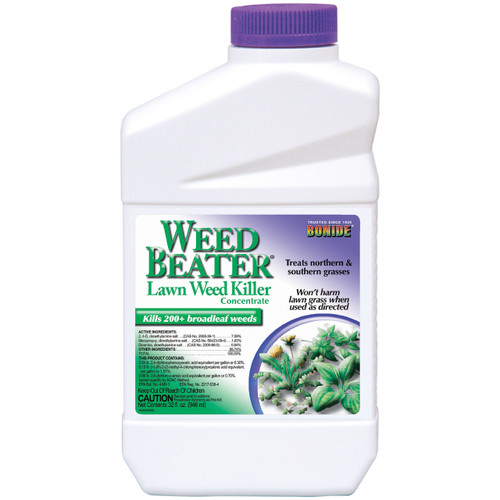Nature’s Wisdom 20% Vinegar Herbicide for Control of Weeds is a quick-acting, non-selective contact herbicide containing an organic acid for which the resi-dues degrade promptly in the soil. Foliar contact results in rapid desiccation and control of annual weeds and grasses, and top growth reduction of herbaceous perennial weeds and grasses (see below). Nature’s Wisdom 20% Vinegar may be applied up to two days before harvest.
WEEDS CONTROLLED: Annual Broadleaf Weeds: Black medic, Black nightshade, Chickweed, Cinquefoil (rough), Common groundsel, Hairy nightshade, Henbit, Lambsquarters, Mustard spp., Oxalis spp., Pigweed spp., Ragweed spp., Shepherds purse, Smartweed (Ladysthumb), and Velvetleaf Perennial Broadleaf Weeds: Amaranth spp., Canada thistle, Cinquefoil (silvery), Dandelion, Ground ivy, Milkweed, Plantain spp., Toadflax, Tufted vetch, Wild carrot, and Moss Annual Grasses: Barnyardgrass, Crabgrass, Foxtail spp., Italian ryegrass, and Poa annua Perennial Grasses: Bluegrass, Nutsedge, Quackgrass, and Witchgrass.
EARLY SEASON ANNUAL WEED CONTROL: Apply this product when weeds are small (3 to 5 leaf stage) and actively growing. Spray this product on unwanted weeds (vegetation) to the point of wetness. For best results spray in full sunshine at temperatures above 65 degrees Fahrenheit. Since dilution of this product will reduce effectiveness, do not dilute. Avoid spraying landscape plants, ornamentals and other desirable foliage as this product causes severe injury to desirable plants. NOTE: ALL CONTACTED VEGETATION WILL BE AFFECTED. DO NOT ALLOW THIS PRODUCT TO COME IN CONTACT WITH DESIRABLE PLANTS. OVERSPRAY OR DRIFT WILL INJURE OR KILL CONTACTED VEGETATION INCLUDING ANY CROP PLANTS. Turf and Ornamental: Such as but not limited to woody ornamentals, potted crops, foliage plants, greenhouses, shade houses, and any other plant production structure in which the product can be applied without contacting desirable plants. Applications to weeds in turf will kill surrounding turf. Root and Tuber vegetables and Leaves of Root and Tuber Vegetables: Such as but not limited to carrot, potato, radish, sugar beet, turnip tops, garden beet leaves, sugar beet leaves. Do not broadcast within the growing crop. Apply only with shielded or hooded spray equipment to weeds growing between crop rows. Bulb Vegetables: Such as but not limited to onion, green onion, shallots and garlic. Leafy Vegetables: Such as but not limited to celery, head lettuce, leaf lettuce, spinach. Do not broadcast within the growing crop. Apply only with shielded or hooded spray equipment to weeds growing between crop rows. Brassica vegetables - Cole crops: Such as but not limited to broccoli, cauliflower, cabbage, collard and mustard greens. Do not broadcast within the growing crop. Apply only with shielded or hooded spray equipment to weeds growing between crop rows. Legume vegetables and leaves of legume vegetables: Such as but not limited to soybeans, peas, beans, guar and their leaves. Fruiting Vegetables: Such as but not limited to tomato, bell pepper, chili pepper, eggplant and okra. Do not broadcast within the growing crop. Apply only with shielded or hooded spray equipment to weeds growing between crop rows. Cucurbit Vegetables: Such as but not limited to cucumber, squash, cantaloupe, watermelon. Do not broadcast within the growing crop. Apply only with shielded or hooded spray equipment to weeds growing between crop rows. Citrus Fruits: Such as but not limited to orange, grapefruit, lemon and lime. For all fruit crops spray must be directed under the crop canopy. Application equipment must be hooded or shielded. Any contact with the crop will cause crop injury. Pome Fruit: Such as but not limited to apple and pear. For all fruit crops spray must be directed under the crop canopy. Application equipment must be hooded or shielded. Any contact with the crop will cause crop injury. Stone fruit: Such as but not limited to cherry, peach, nectarine and plum. For all fruit crops spray must be directed under the crop canopy. Application equipment must be hooded or shielded. Any contact with the crop will cause crop injury. In crops where cultivation is possible, cultivate crop middles and reduce the sprayed area by directing the application to the uncultivated base of crop plants. Berries and small fruit: Such as but not limited to strawberry, blackberry, raspberry, blueberry, cranberry, grapes, lingonberry, Saskatoon berry, kiwi fruit, and maypop. For all fruit crops spray must be directed under the crop canopy. Application equipment must be hooded or shielded. Any contact with the crop will cause crop injury. In crops where cultivation is possible, cultivate crop middles and reduce the sprayed area by directing the application to the uncultivated base of crop plants. Tree nuts: Such as but not limited to almond, pecan, pistachio, coconut, betel nut, cashew and walnut. For all nut crops spray must be directed under the crop canopy. Application equipment must be hooded or shielded. Any contact with the crop will cause crop injury. Cereal grains and their straw or fodder: Such as but not limited to corn, rice, wheat, rye, barley, millet, sorghum, and amaranth. Do not apply to flooded rice. In corn or other crops where cultivation is possible, cultivate crop middles and reduce the sprayed area by directing the application to the uncultivated base of crop plants. Utilize shielded sprays to protect crop plants and reduce drift. Forage crops - Grass and Non Grass Animal feeds: Such as but not limited to bermudagrass, fescue, bluegrass, clover, and alfalfa. Herbs and Spices: Such as but not limited to basil, dill, chive, parsley, cilantro, celery seed, and dill seed. Do not broadcast within the growing crop. Apply only with shielded or hooded spray equipment to weeds growing between crop rows. Oilseed crops: Such as but not limited to canola, sunflower, flax, rapeseed, mustard, guayule, and crambe. Do not spray broadcast within the growing crop. Apply only with shielded or hooded spray equipment to weeds growing between crop rows. In sunflower or other upright crops where cultivation is possible, cultivate crop middles and reduce the sprayed area by directing the application to the uncultivated base of crop plants. Tropical fruit: Such as but not limited to avocado, guava, jujube, noni, mango, star fruit, sugar apple, papaya, lychee, passion fruit, banana, date, olive, tamarind, and pineapple. For all fruit crops spray must be directed under the crop canopy. Application equipment must be hooded or shielded. Any contact with the crop will cause crop injury. Medicinal crops: Such as but not limited to echinacea, St Johns wort, ginkgo, valerian, and ginseng. Do not broadcast within the growing crop. Apply only with shielded or hooded spray equipment to weeds growing between crop rows. In ginkgo or other upright crops where cultivation is possible, cultivate crop middles and reduce the sprayed area by directing the application to the uncultivated base of crop plants. Mushrooms: Apply preplant only. Do not apply directly to mushroom beds. Miscellaneous crops: Such as but not limited to aloe vera, Prickly pear cactus, sugar maple and sweet sorghum for syrup production, peanuts, sugarcane, artichoke, cotton, asparagus, kava kava, mint, hops, stevia, jojoba, hemp, tobacco, tea, and coffee. FOR SPOT TREATMENT APPLICATION: Direct spray with a single nozzle or a hand-gun applicator to thoroughly wet undesirable weed foliage. Re-treatment of perennial weed growth may be required for control. FOR BROADCAST SPRAY APPLICATIONS: For broadcast spray application to control weeds. Application types include pre-plant (prior to crop establishment), preharvest desiccation (to kill crop foliage prior to harvesting the crop) postharvest crop desiccation (remaining crop residues after crop has been harvested). Use 15 to 30 gallons of this product per acre. Thorough coverage is necessary to achieve desirable control. For dense weed populations and/or heavy foliage, use the higher spray volume to ensure adequate coverage. Apply with flat fan nozzles and at sufficient pressure to achieve required coverage, but do not exceed a pressure 35 PSI. When applying this product in a broadcast application within a growing crop, utilize a hooded sprayer, shielded, or other spray equipment that prevents the movement of spray away from the target. For pre-plant burndown of young vegetation, use of wide angle nozzles (110 degrees or wider) spaced close together enable the boom to be positioned lower and closer to the spray target, reducing the potential for drift. POST- DIRECTED: (Row middles, shielded sprayer or hooded sprayer): For spray application to control weeds, apply 15 to 30 gallons of this product per acre. Thorough coverage is necessary to achieve desirable control. For dense and/or heavy weed populations, use the higher spray volume to ensure adequate coverage. Apply with flat fan nozzles and at the lowest pressure needed to achieve required coverage, but do not exceed 35 PSI. If treating along the side of crop plants, shielded or hooded sprayers must be used to avoid crop injury. SPRAY EQUIPMENT: Do not apply this product by aerial application. Do not apply when wind conditions favor movement of spray away from the site of application. When applying this product in a broadcast application utilize a hooded sprayer, shielded, or other spray equipment that prevents the movement of spray away from the target. Utilize nozzles that are designed to produce large spray droplets to reduce drift. Spray nozzles need to be plastic or 316 stainless steel as this product will eventually corrode any other metal. FOR CONTROL OF LARGER ANNUALS AND BURNDOWN OF PERENNIAL WEED GROWTH: Larger annual weeds and perennials are more difficult to control and may require retreatment. Treat initially as recommended above and repeat if new growth of leaves appears. Thorough coverage of all weed foliage is necessary to achieve desirable control. To reduce the amount of product required to control well-established weed stands, mow to a height of 4-6 inches and remove cut vegetation before applying this product. TIMING OF APPLICATIONS: Best results are achieved from applications to actively growing young weeds. Weeds that are mature, dormant, or hardened due to moisture stress are more tolerant of herbicide treatments. For best results spray in full sunshine at temperatures above 65°F. Only contacted vegetation will be affected. Do not apply this product through any type of irrigation system. Note: all contacted vegetation will be affected. do not allow this product to come in contact with desirable plants. overspray or drift will injure or kill contacted vegetation including any crop plants.















